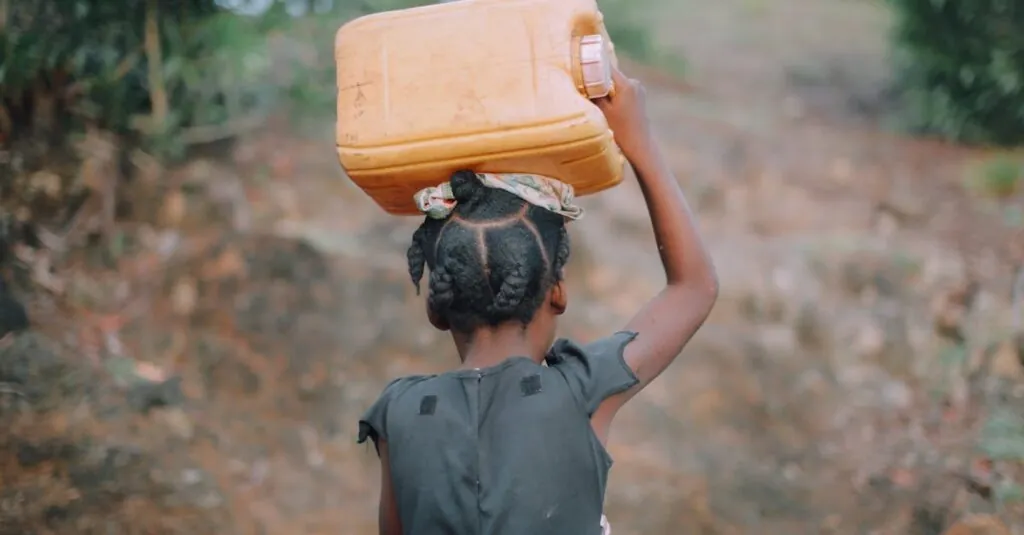In a world where surprises lurk around every corner, the Country Resilience Index (CRI) stands as a superhero in disguise. Think of it as the ultimate scorecard for nations, measuring their ability to bounce back from crises like a rubber band on a mission. Whether it’s natural disasters or economic downturns, some countries seem to have a secret stash of resilience, while others are still figuring out how to tie their shoelaces.
Table of Contents
ToggleOverview of Country Resilience Index
The Country Resilience Index (CRI) serves as a crucial measurement for evaluating how effectively nations recover from various challenges. This index assesses factors such as infrastructure, governance, and social cohesion, which contribute to a nation’s overall resilience. Various metrics underlie the CRI, including economic stability, environmental sustainability, and health care effectiveness.
Different countries display varied resilience levels, impacting their recovery processes. Nations with robust infrastructure often withstand crises better than those with weaker systems. Data indicates that countries scoring high on the CRI tend to have strong emergency response frameworks in place, facilitating quicker recovery post-crisis.
Additionally, social factors play a significant role in resilience rankings. Strong community ties and civic engagement can enhance a country’s ability to adapt during crises. Recent studies highlight how trust in government correlates with higher resilience scores, indicating that effective leadership fosters public confidence.
CRIs vary widely among countries, revealing disparities in how nations prepare for and respond to disasters. For instance, nations in regions prone to natural disasters often invest more in disaster preparedness. This proactive approach typically reflects in better CRI scores.
Evaluating the CRI allows policymakers to identify strengths and weaknesses in national systems and improve resilience strategies. Comprehensive assessments can lead to targeted investments in infrastructure and community programs. Understanding the CRI facilitates global collaboration, ensuring countries learn from one another’s experiences to enhance their resilience capabilities.
Importance of Measuring Resilience
Measuring resilience is critical for understanding a nation’s ability to navigate crises. It highlights areas needing improvement and helps countries prepare for future challenges.
Economic Factors
Economic stability plays a crucial role in a nation’s resilience. Countries with strong economies can allocate resources effectively in times of crisis. Factors such as gross domestic product (GDP), employment rates, and diverse industries contribute to this stability. Nations with high GDP often display better recovery capacities following disasters. Investments in infrastructure, job creation, and fiscal policies promote economic resilience. Data shows that resilient economies possess the agility to adapt to shifts, ensuring immediate response necessities are met. Countries focusing on economic diversity enhance their abilities to withstand shocks, reducing dependency on specific sectors.
Social Factors
Social cohesion proves vital for resilience performance. Community ties, trust in government, and active civil society engagement influence recovery outcomes. Societies with strong interpersonal relationships exhibit better support systems during crises. Countries with high levels of trust in leadership often experience quicker recovery durations. Furthermore, engaged communities frequently mobilize resources and volunteers effectively. Studies indicate that resilient nations prioritize social equity, reducing vulnerabilities among their populations. Programs promoting community involvement and collaboration strengthen societal resilience, fostering networks capable of rapid response during emergencies.
Environmental Factors
Environmental sustainability remains a significant factor in assessing resilience. Nations that invest in green technologies and practices prepare better for environmental challenges. Such investments lead to reduced risks associated with climate change, protecting lives and infrastructure. Countries with strong environmental policies often showcase lower vulnerability exposure. Sustainable land-use practices contribute to long-term resilience through ecosystem preservation. Moreover, healthy ecosystems provide essential services that aid recovery after disasters. Effective environmental strategies enhance adaptability while confronting ongoing global changes, demonstrating the importance of integrating sustainability into resilience planning.
Methodology for Assessing Resilience
The methodology for assessing resilience focuses on systematic data collection and thorough analysis techniques. These elements work together to provide a clear understanding of a nation’s capacity to recover from crises.
Data Collection
Data collection involves gathering quantitative and qualitative information from diverse sources. National governments contribute official statistics related to economic conditions, healthcare effectiveness, and infrastructure quality. Surveys capture community sentiments regarding social cohesion and trust in governance. Additionally, international organizations provide comparative data on resilience metrics, offering insights into best practices across different regions. Reports and case studies from disaster response efforts reflect real-world resilience experiences. Engaging local communities helps capture nuanced information that larger datasets may overlook. Collectively, this information forms a comprehensive picture of national resilience.
Analysis Techniques
Analysis techniques focus on interpreting collected data to derive meaningful insights. Statistical methods calculate resilience scores, enabling comparisons among countries based on various metrics. Regression analysis identifies correlations between resilience factors such as social equity and recovery speed. Additionally, geographic information systems (GIS) visualize vulnerability and resource distribution, aiding in understanding spatial relationships. Scenario modeling predicts potential resilience outcomes based on historical data and current trends. Qualitative analysis draws from interviews and surveys, highlighting community perspectives on resilience. Combining these techniques allows for a holistic assessment of national resilience capabilities.
Case Studies of Country Resilience Index
The Country Resilience Index (CRI) illustrates how nations fare in terms of recovery capability. Analysis reveals varying resilience levels across countries.
High Resilience Countries
Countries like Norway and New Zealand often rank high on the CRI. Their strong infrastructure supports emergency response efforts efficiently. Governance in these nations emphasizes transparency, building public trust and facilitating cooperation during crises. A robust healthcare system enables timely medical responses, which significantly boosts recovery rates. Economic stability provides additional resources for disaster preparedness measures. Community cohesion also plays a crucial role, allowing citizens to mobilize quickly when needed. These factors combined contribute to Norway and New Zealand’s exceptional resilience scores.
Low Resilience Countries
In contrast, countries such as Haiti and Afghanistan struggle with low CRI rankings. Weak infrastructure hampers disaster response capabilities, exposing populations to significant vulnerabilities. Poor governance and political instability lead to mistrust among citizens, complicating recovery efforts. Healthcare systems in these nations often fall short, resulting in inadequate responses to crises. Limited economic resources restrict the ability to invest in resilience initiatives. Social fragmentation can further weaken community ties, making collective recovery efforts challenging. The interplay of these factors highlights the substantial challenges faced by nations with low resilience scores.
Challenges in Implementing the Index
Implementing the Country Resilience Index (CRI) presents various challenges. Data availability often hinders accurate assessments, especially in regions with limited resources. Nations may lack comprehensive datasets, complicating the measurement of critical resilience factors.
Lack of standardization poses another challenge. Different countries define key metrics—such as economic stability and environmental sustainability—variously, leading to inconsistent evaluations. Aligning these definitions across diverse national contexts proves difficult.
Cultural differences also impact the adoption of the CRI. Social cohesion varies widely, affecting community engagement and participation in resilience initiatives. When societies do not prioritize collaboration, the effectiveness of resilience strategies diminishes.
Political will represents a significant barrier as well. Governments may prioritize short-term economic gains over long-term resilience investments. A lack of commitment to fostering strong infrastructure and community support can stagnate progress.
Additionally, integrating feedback from local populations remains crucial. Policymakers often overlook community insights, reducing the index’s relevance. Engaging stakeholders ensures that resilience assessments reflect on-the-ground realities.
Funding constraints frequently limit the implementation of resilience strategies. Countries with struggling economies may divert resources from resilience efforts to address immediate needs. Limited financial investment leads to inadequate infrastructure and emergency response capabilities.
Evaluating the interplay of these challenges illuminates the complexities surrounding the CRI. Effective implementation demands addressing data, cultural, and political obstacles while promoting local engagement. Focusing on these areas strengthens nations’ resilience frameworks, enhancing their ability to recover from crises.
The Country Resilience Index serves as a crucial benchmark for understanding how nations can withstand and recover from crises. By focusing on infrastructure governance and social cohesion it highlights the disparities in resilience among countries. Those that prioritize economic stability and environmental sustainability tend to fare better in the face of challenges.
Moreover the CRI not only aids policymakers in identifying areas for improvement but also fosters global collaboration. By learning from one another’s experiences countries can enhance their resilience strategies. As the world faces increasing threats from climate change and economic instability investing in resilience is more important than ever. The CRI provides a pathway for nations to build stronger more adaptable systems that can withstand future adversities.






